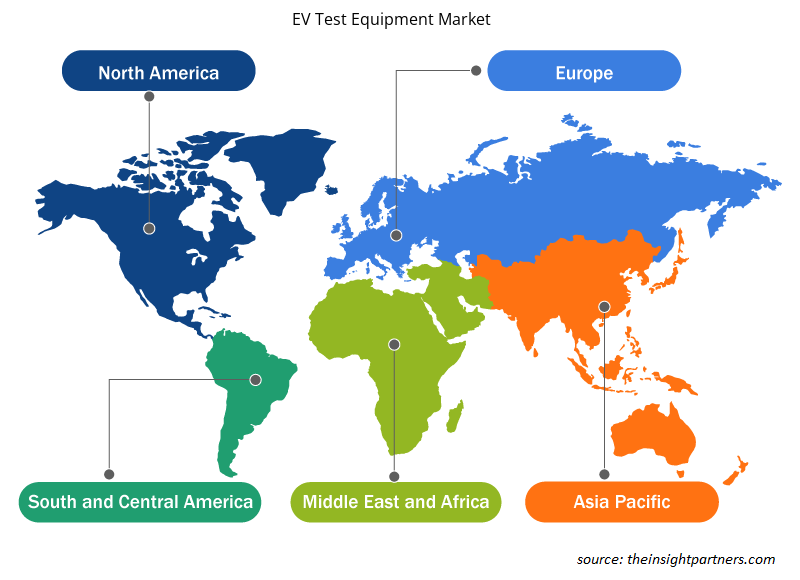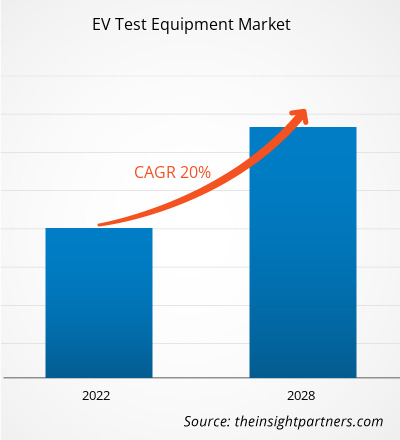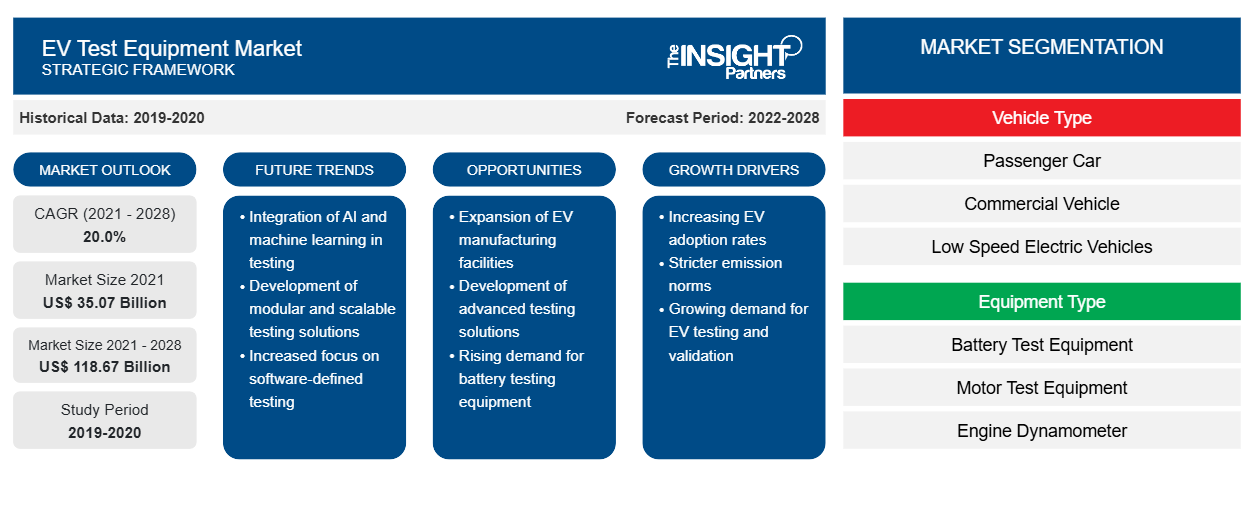من المتوقع أن ينمو سوق معدات اختبار المركبات الكهربائية من 35،072.54 مليون دولار أمريكي في عام 2021 إلى 118،671.47 مليون دولار أمريكي بحلول عام 2028؛ ومن المتوقع أن ينمو بمعدل نمو سنوي مركب قدره 20.0٪ من عام 2022 إلى عام 2028.
تُستخدم معدات اختبار المركبات الكهربائية لفحص مكونات المركبات الكهربائية المختلفة مثل البطاريات والمحركات والمكونات الأخرى للحفاظ على تفوق أجزاء السيارات على المنافسين وتوفير أداء مضمون وضمان سلامة العملاء ورضاهم. تُستخدم معدات الاختبار في المركبات الكهربائية لتقييم الأداء الإجمالي للمركبة واختبار بطارية وشاحن المركبات الكهربائية واختبار إلكترونيات الطاقة واختبار المحرك والمقياس الديناميكي. تُستخدم معدات اختبار المحرك للتحقق من عزم الدوران أو الإشارة الكهربائية والسرعة العالية للسيارة الكهربائية، باستخدام أجهزة الاستشعار ومجسات الجهد وبرامج أخرى.
وقد تعززت مبيعات السيارات الكهربائية بفضل الطلب المتزايد على المركبات التي تعمل بالوقود البديل والتنقل المتصل. وللحد من انبعاثات السيارات والتلوث، تبنت العديد من الحكومات قواعد تشجع على استخدام المركبات الكهربائية. ومن المتوقع أن يتطور سوق معدات اختبار المركبات الكهربائية بسبب الطلب المتزايد على المركبات الكهربائية. وعلاوة على ذلك، تسمح الفولتية الأعلى بالشحن بشكل أسرع، مما يؤدي إلى اعتماد بطاريات عالية الأداء وناقلات الحركة وأجهزة الشحن. ونتيجة لذلك، فإن الطلب على معدات وبرامج اختبار المركبات الكهربائية مدفوع بالتقدم التكنولوجي في تقنيات البطاريات الجديدة، وزيادة الطلب على الوظائف والميزات الإلكترونية في السيارة، وقواعد الانبعاثات الصارمة.
وفقًا لموقع EV-Volumes.com، كان عام 2020 عامًا ممتازًا للسيارات الهجينة القابلة للشحن، حيث وصلت مبيعات السيارات الهجينة القابلة للشحن والسيارات الهجينة القابلة للشحن على مستوى العالم إلى 3.2 مليون وحدة. وسجلت أوروبا 1.4 مليون سيارة كهربائية في عام 2020، بزيادة 137% عن عام 2019، حتى بعد ظهور جائحة كوفيد-19. كانت هذه الزيادة كبيرة بشكل ملحوظ بالنسبة لسوق انخفض بنسبة 20% على أساس سنوي. علاوة على ذلك، تفوقت أوروبا على الصين في سوق السيارات الكهربائية لأول مرة منذ عام 2015. علاوة على ذلك، تستأنف العديد من الشركات خدمات النقل العام، مما يتطلب تنفيذ العديد من تدابير ومعايير السلامة.
إن ظهور حلول برمجية جديدة، مثل الحلول الرقمية القائمة على السحابة لإدارة الأسطول في الوقت الفعلي وتسريع التحول إلى الكهرباء، يشكل سوق معدات اختبار المركبات الكهربائية العالمية. على سبيل المثال، يتيح برنامج إدارة الشحن الذي تقدمه EVBox للمستخدمين تتبع وإدارة وتحسين تجربة قيادة المركبات الكهربائية الخاصة بهم. ومن ثم، لمراقبة ذلك، ستكون حلول الاختبار الفعّالة المتكاملة مع الذكاء الاصطناعي مطلوبة بشدة خلال فترة التنبؤ.
قم بتخصيص هذا التقرير ليناسب متطلباتك
ستحصل على تخصيص لأي تقرير - مجانًا - بما في ذلك أجزاء من هذا التقرير، أو تحليل على مستوى الدولة، وحزمة بيانات Excel، بالإضافة إلى الاستفادة من العروض والخصومات الرائعة للشركات الناشئة والجامعات
- احصل على أهم اتجاهات السوق الرئيسية لهذا التقرير.ستتضمن هذه العينة المجانية تحليلاً للبيانات، بدءًا من اتجاهات السوق وحتى التقديرات والتوقعات.
تأثير جائحة كوفيد-19 على سوق معدات اختبار المركبات الكهربائية في أوروبا
كان لتفشي فيروس كورونا المستجد (كوفيد-19) والطريق نحو التعافي تأثيرات مختلفة على شبكات الطرق. فقد شهدنا زيادة في شراء معدات اختبار المركبات الكهربائية في جميع أنحاء أوروبا في عام 2020. على سبيل المثال، سجلت ألمانيا وفرنسا وإيطاليا مبيعات أعلى للسيارات الكهربائية بنسبة 55% في أوروبا خلال النصف الأول من عام 2020 مقارنة بعام 2019. ويرجع نمو سوق معدات اختبار المركبات الكهربائية في أوروبا إلى الحاجة المتزايدة لدى الشركات المصنعة للامتثال لمعايير ثاني أكسيد الكربون الأكثر صرامة التي وضعها الاتحاد الأوروبي للسيارات الجديدة والشاحنات الصغيرة اعتبارًا من يناير 2020. يتخصص معهد VDE الذي يقع مقره في ألمانيا في العلوم والتوحيد القياسي واختبار المنتجات والشهادات والاستشارات التطبيقية. في عام 2019، تم تعيين معهد VDE كخدمة فنية من الفئة A وB وD من قبل هيئة النقل الفيدرالية لمركبات السيارات، مما يمكّنه من إجراء اختبارات على المركبات الكهربائية بناءً على قانون المرور على الطرق السريعة وقانون أجزاء المركبات واللوائح وفقًا لاتفاقية اللجنة الاقتصادية للأمم المتحدة في أوروبا (لوائح ECE). تضمن الاختبارات والشهادات التي ينفذها معهد VDE سهولة التنقل وأمن البيانات في النظام الإجمالي، والذي يشمل البنية الأساسية للشحن ومحطات الشحن وصناديق الحائط خلال مرحلة التطوير المبكر للمنتج لاختبارات الموافقة النهائية (التحقق). إن وجود سوق كبير للسيارات الكهربائية، والمؤسسات التي لديها عقود من الخبرة في اختبار السلامة الكهربائية، والمتطلبات المتزايدة لاختبار المكونات الإلكترونية المدمجة في السيارة، تعمل على دفع نمو سوق معدات اختبار السيارات الكهربائية في أوروبا.
رؤى السوق لمعدات اختبار المركبات الكهربائية
تعمل شركات محطات شحن المركبات الكهربائية على تطوير تقنيات محطات الشحن المبتكرة مثل الشحن التوربيني وشحن تيرا إتش بي وأنظمة الشحن الذكية ونقل الطاقة اللاسلكية والشواحن ثنائية الاتجاه. تتطلب مثل هذه التطورات في أنظمة شحن المركبات الكهربائية تقنيات اختبار محسنة. تتوفر أنظمة اختبار محطات شحن المركبات الكهربائية من شركات بما في ذلك ROLEC وDEKRA وTUV Rheinland. يعد الشحن الذكي أحد أكثر أنظمة الشحن تقدمًا. يسمح الشحن الذكي بموازنة الحمل والتوزيع النسبي لسعة الطاقة المتاحة عبر جميع محطات الشحن النشطة. كما يسهل جمع بيانات الشحن المهمة من محطات مختلفة باستخدام منصة إدارة واحدة قائمة على السحابة.
رؤى السوق بناءً على نوع السيارة
بناءً على نوع السيارة، يتم تقسيم سوق معدات اختبار المركبات الكهربائية إلى سيارات الركاب والمركبات التجارية والمركبات الكهربائية منخفضة السرعة . في عام 2021، استحوذ قطاع سيارات الركاب على أكبر حصة في سوق معدات اختبار المركبات الكهربائية.
رؤى السوق بناءً على نوع المعدات
بناءً على نوع المعدات، يتم تقسيم سوق معدات اختبار المركبات الكهربائية إلى معدات اختبار البطارية، ومعدات اختبار المحرك، ومقياس قوة المحرك، ومقياس قوة الهيكل، ومقياس قوة ناقل الحركة، واختبار مضخة حقن الوقود، واختبار العاكس، واختبار نظام نقل الحركة في المركبات الكهربائية، والشاحن الموجود على متن المركبة، وAC/DC EVSE. في عام 2021، استحوذ قطاع معدات اختبار البطارية على أكبر حصة في سوق معدات اختبار المركبات الكهربائية.
رؤى السوق القائمة على التطبيقات
بناءً على التطبيق، يتم تقسيم سوق معدات اختبار المركبات الكهربائية إلى أنظمة مكونات المركبات الكهربائية وناقل الحركة، وشحن المركبات الكهربائية، وناقل الحركة. في عام 2021، استحوذ قطاع ناقل الحركة على أكبر حصة في سوق معدات اختبار المركبات الكهربائية.
رؤى السوق المستندة إلى المستخدمين النهائيين
بناءً على المستخدمين النهائيين، يتم تقسيم سوق معدات اختبار المركبات الكهربائية إلى شركات تصنيع المعدات الأصلية، والموردين من الدرجة الأولى، والباحثين والأكاديميين، وغيرهم. في عام 2021، استحوذت شريحة الموردين من الدرجة الأولى على أكبر حصة في سوق معدات اختبار المركبات الكهربائية.
يتبنى اللاعبون في السوق استراتيجيات مثل عمليات الدمج والاستحواذ ومبادرات السوق للحفاظ على مواقعهم في توقعات سوق معدات اختبار المركبات الكهربائية. فيما يلي قائمة ببعض التطورات التي قام بها اللاعبون الرئيسيون في تقرير سوق معدات اختبار المركبات الكهربائية:
- تم الإعلان عن إطلاق مركز الابتكار الهندسي (EIC) التابع لـ NI في بنغالور في مارس 2022. سيساعد المرفق الهندسي عملاء NI وشركائها والشركات الناشئة التي تخدم قطاع الطيران والجيش المحلي. سيتم أيضًا استخدام EIC لتعليم الجيل القادم من المهندسين في صناعات الطيران والجيش حول فهم النظام.
- في عام 2021، تعاونت Keysight Technologies, Inc. وProventia Oy لتطوير حلول اختبار البطاريات للسيارات الكهربائية. وتؤدي الشراكة بين Keysight وProventia إلى إنشاء منشأة اختبار آمنة لا تعتمد على الموقع ويمكن تنفيذها بسرعة.
رؤى إقليمية حول سوق معدات اختبار المركبات الكهربائية
لقد قام المحللون في Insight Partners بشرح الاتجاهات والعوامل الإقليمية المؤثرة على سوق معدات اختبار المركبات الكهربائية طوال فترة التوقعات بشكل شامل. يناقش هذا القسم أيضًا قطاعات سوق معدات اختبار المركبات الكهربائية والجغرافيا في جميع أنحاء أمريكا الشمالية وأوروبا ومنطقة آسيا والمحيط الهادئ والشرق الأوسط وأفريقيا وأمريكا الجنوبية والوسطى.

- احصل على البيانات الإقليمية المحددة لسوق معدات اختبار المركبات الكهربائية
نطاق تقرير سوق معدات اختبار المركبات الكهربائية
| سمة التقرير | تفاصيل |
|---|---|
| حجم السوق في عام 2021 | 35.07 مليار دولار أمريكي |
| حجم السوق بحلول عام 2028 | 118.67 مليار دولار أمريكي |
| معدل النمو السنوي المركب العالمي (2021 - 2028) | 20.0% |
| البيانات التاريخية | 2019-2020 |
| فترة التنبؤ | 2022-2028 |
| القطاعات المغطاة | حسب نوع السيارة
|
| المناطق والدول المغطاة | أمريكا الشمالية
|
| قادة السوق وملفات تعريف الشركات الرئيسية |
|
كثافة اللاعبين في سوق معدات اختبار المركبات الكهربائية: فهم تأثيرها على ديناميكيات الأعمال
يشهد سوق معدات اختبار المركبات الكهربائية نموًا سريعًا، مدفوعًا بالطلب المتزايد من المستخدم النهائي بسبب عوامل مثل تفضيلات المستهلكين المتطورة والتقدم التكنولوجي والوعي المتزايد بفوائد المنتج. ومع ارتفاع الطلب، تعمل الشركات على توسيع عروضها والابتكار لتلبية احتياجات المستهلكين والاستفادة من الاتجاهات الناشئة، مما يؤدي إلى زيادة نمو السوق.
تشير كثافة اللاعبين في السوق إلى توزيع الشركات أو المؤسسات العاملة في سوق أو صناعة معينة. وهي تشير إلى عدد المنافسين (اللاعبين في السوق) الموجودين في مساحة سوق معينة نسبة إلى حجمها أو قيمتها السوقية الإجمالية.
الشركات الرئيسية العاملة في سوق معدات اختبار المركبات الكهربائية هي:
- شركة ناشيونال انسترومنتس
- شركة هوريبا المحدودة
- شركة أربين للأدوات
- شركة ماكور
- شركة كيسايت للتكنولوجيا
إخلاء المسؤولية : الشركات المذكورة أعلاه ليست مرتبة بأي ترتيب معين.

- احصل على نظرة عامة على أهم اللاعبين الرئيسيين في سوق معدات اختبار المركبات الكهربائية
ملفات تعريف الشركة
- شركة ناشيونال انسترومنتس
- شركة هوريبا المحدودة
- شركة أربين للأدوات
- شركة ماكور
- شركة كيسايت للتكنولوجيا
- فرويد، المحدودة
- عناصر التحكم في دينوميرك
- شركة كومسو للإلكترونيات المحدودة
- مجموعة الدر
- توف راينلاند
- مجموعة إنترتك المحدودة
- شركة تويو سيستم المحدودة
- شركة وونيك بي إن إي المحدودة
- التحليل التاريخي (سنتان)، سنة الأساس، التوقعات (7 سنوات) مع معدل النمو السنوي المركب
- تحليل PEST و SWOT
- حجم السوق والقيمة / الحجم - عالمي، إقليمي، بلد
- الصناعة والمنافسة
- مجموعة بيانات إكسل
التقارير الحديثة
شهادات العملاء
سبب الشراء
- اتخاذ قرارات مدروسة
- فهم ديناميكيات السوق
- تحليل المنافسة
- رؤى العملاء
- توقعات السوق
- تخفيف المخاطر
- التخطيط الاستراتيجي
- مبررات الاستثمار
- تحديد الأسواق الناشئة
- تحسين استراتيجيات التسويق
- تعزيز الكفاءة التشغيلية
- مواكبة التوجهات التنظيمية























 احصل على عينة مجانية ل - سوق معدات اختبار المركبات الكهربائية
احصل على عينة مجانية ل - سوق معدات اختبار المركبات الكهربائية